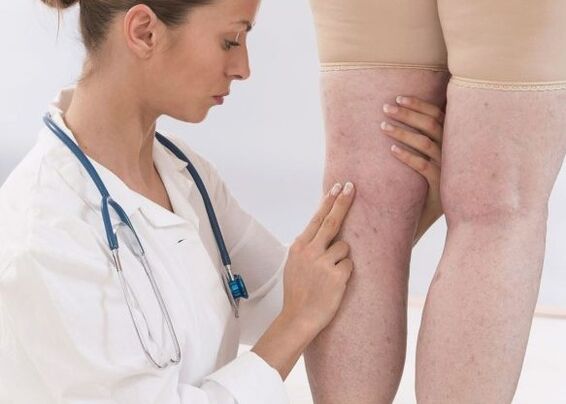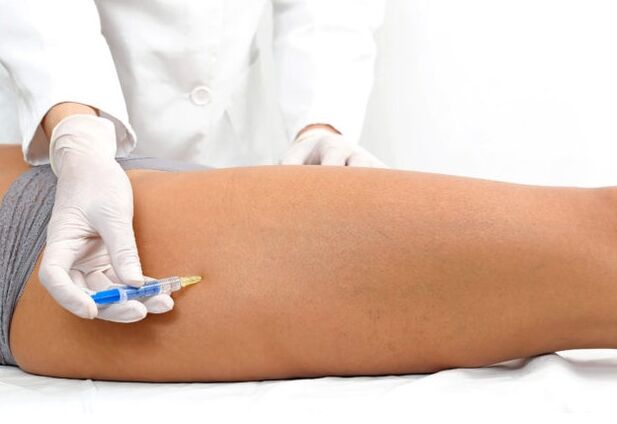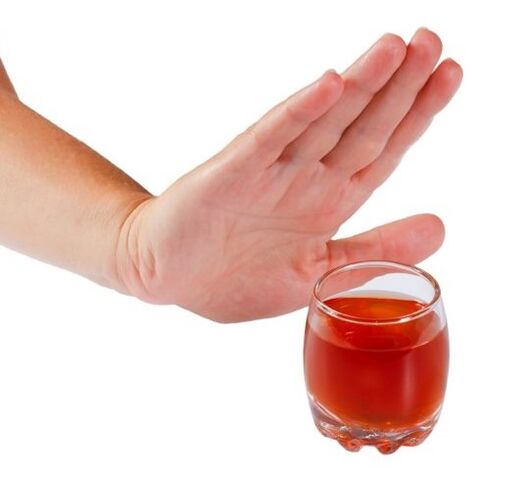Problems with the vascular system of the legs can be found in more than half of the planet's population. The greatest discomfort gives patients with a phlebologist varicose veins on their feet. The pathology is characterized by a decrease in the tone of the walls of the blood vessels and the expansion of its lumen. As a result of the hanging of the foot veins, the reverse blood flow in the human body is disturbed. In what complications are the varicose veins and how to fought them correctly and we understand our material.

General properties and causes of varicose veins
Caps in the operation of the vascular system of the legs are initially formed against the background of the improper operation of the venous valves. Here it is worth knowing that blood from the heart flows freely to the lower limbs due to gravity. In the opposite direction, the blood circulation moves under the influence of the natural pressure that creates the walls of healthy vessels. This wave is sufficient to overcome the power of earthly attraction.
When the sound of blood vessels is disturbed, the body makes all possible efforts to accelerate the vessels. This means that this increases blood pressure (blood pressure) independently. The venous flaps work worse out of such "efforts" without completely closing their wings with every blow to the human heart. In this case, the blood is actively entered from deep veins into superficial, which causes its additional reperation.
The causes of varicose veins of the lower extremities are the following factors:
- Inheritance (transfer of the disease by a male or female line).
- Hormonal malfunctions against the background of autoimmune processes, pregnancy, birth or diseases of the reproductive system.
- A sedentary nature of activity or vice versa that is connected to the legs for a long time.
- A sitting lifestyle.
- Obesity (obesity).
- Power exercises with weights from a session or a crouch.
- Smoking and drinking alcohol.
- Long stay under the straight sun rays.
Symptoms and the first signs
The symptoms of varicose veins can vary to a degree or the other degree of the patient and the stage of the course of the disease. In addition, the signs of pathology are not always obvious. The only common feature of varicose veins is a state that is referred to as "heavy legs". This means that in one of the phases of the pathology, the patient feels the severity in the legs at the end of the working day or even the morning after sleep.
I and II Stadium of varicose veins: signs and symptoms
The initial stages of vascular pathology of the legs are characterized by special characters. The following symptoms are found in 1 stage:
- a vascular pattern in the form of stars or a blink on the legs;
- Swelling of the legs after wearing shoes and even socks;
- Night cramps in the calf muscle;
- Fatigue and severity in the legs.
In 2 phases of pathology, the patient forms the following symptoms:
- Swelling of the veins after a long time of walking in uncomfortable shoes or after a long time;
- Visualization of vessels that have been enlarged on the vascular volume;
- protruding and protruding knots in the veins of the legs;
- Itching in places inflamed veins;
- Reddening of the skin.
III and IV Stadium of the varicose veins
Progressive varicose veins are already characterized by signs of complications. The picture looks like this:

- Stage 3. Against the background of the patient's symptoms, it accompanies almost constant swelling of the legs. It can sometimes fall until morning.
- Stage 4. The patient in reddening the skin begins with the beginning of the ulcerative formations. The place of the future trophic ulcer is covered with white iron as with a painted plaque. During his injury, a trophic ulcer is opened that looks almost constantly. The situation is dangerous in that ulcers can be infected a second time. This leads to a vibration of inflammation points.
When to see a doctor and what to do with what
At the first symptoms of the early stages of varicose veins, you should contact a phlebologist. This doctor is busy with blood vessels. If there is no doctor in your clinic, you can get advice with an angiosurgeon or just a surgeon. It is to be understood that in the initial phases in order to develop the process of developing varicose veins with conservative methods. The competent tactics of treatment and compliance with all doctor bonds enables you to feel lightness in your legs again.
Diagnosis
For the competent and effective treatment of varicose veins on the legs, you must first make a precise diagnosis. That means to identify the degree of the vascular problem. The following methods are used for the diagnosis of vein pathology on the legs:
- Visual examination of the patient's legs with mandatory palpation of visible vessels.
- Ultrasonic dopperometry or flomie knife with which the doctor can estimate the blood speed on the vessels and the overall occupancy of the foot veins.
- Scanning of ships of the legs. It also enables you to evaluate the condition of the valve system and the veins yourself.
- Thermography. In this case, the infrared radiation is used for diagnosis.
- Echosklerotherapy. The essence of the methodology is the introduction of a sclerosing substance in small doses and a further examination of the vessels to inflamed places.
- Flebography is computer. The technology has the principle of standard -MRI.
- Fleboscintigraphy. Here experts use special radionuclides to examine the lymphatic and venous systems of the legs.
Treatment methods of the lower extremities
Pharmaceutical therapy
With the help of medication, you can treat varicose veins in the early stages. And very effective. The type and the name of the drug are selected depending on the severity of the patient's condition.
For external (local) use, a phlebologist can prescribe medication in the form of gels, creams or ointments.
Anticoagulans are also prescribed for oral administration, which successfully dilute the blood and prevent the formation of blood clots.
Against the background of targeted therapy, the patient is prescribed for the treatment of varicose veins that support the work of the vascular and circulatory systems. Such drugs and additives are therefore shown:
- Vitamins. Vitamin C and vitamins of Group V.
- The ointments are not steroidal anti -inflammatory anti -inflammatory. Remove the inflammatory process perfectly and reduce the reddening of the skin.
- Angoprotectors. Assign to improve the tone of the veins and reduce the permeability of the capillaries.

Surgical treatment of varicose veins with minimally invasive and complete operating methods
In 3-4 stages of varicose veins, surgery is displayed to remove patients with vessels who disturb normal blood flow. Depending on the initial state of the patient, one of the minimally invasive techniques or complete surgical intervention can be used.
Sclerotherapy
This non-surgical type of procedure is to insert special clerosanties (phlebosclerosis substances) into the lumen of the veins. Its basis are alcohols. As a rule, all of these drugs are intended exclusively for intravenous administration by injection. Such substances provoke the destruction of the general endothelial (internal) layer of the vessel and its further narrowing (sclerosis). As a result, the lumen of the vessel is either significantly reduced or fully glued.
Most of the time, doctors use such medication:
- Soap fatty acids and salt. These are Vacoricid, Sylpisole, Sotradikol, Thrombovar or Varicosan.
- Cell toxins. This is a quin with urettan, a solution of experienced 1–5 %, Vistaril, etc.
- Hypertonic compounds dehydrate the intimacy of veins. Sodium salicylate solution is 20–40 %, sodium bromide 30 %, sodium chloride 24 %.
- Organic chewing solutions. Ethyl alcohol, glucose solution 66 %or dextrose.
Combined phlebectomy
Such a technique of surgical intervention implies the use of several techniques at the same time. First of all, the patient marks the whereabouts of all inflamed veins in an upright position. The marking is carried out under the control of the ultrasound of the vessels of the legs.
In the case of complex phlebectomy, the following phases of the surgical interventions are used:
- Crossectomy. Otherwise, the process is referred to as dressing and parallel intersection of the small and/or large subcutaneous vein. The dressing is carried out in the sauce zone with deep vessels of the legs. The crossectomy is carried out by the cut cut, which is formed in the area of the groin fold. Its length is 3-5 cm. Then the surgeon notices a large subcutaneous vein until it falls into femur and pulls the veins. The BPV case (large subcutaneous vena) crosses. Only her stump remains about 5 mm. Then the surgeon leads the following stage of the company from this leak section - stripping.
- Strip. Or otherwise the removal of the tribes of a large or small subcutaneous vein. It is carried out by two endoscopic cuts that are located on both edges of the inflamed vein. In this case there is already a groin cut. This introduces a special probe into the cavity of a painful ship, which at the end has a special thick olive with a cutting edge. The probe moves to the end of the area of the inflamed vessel and is sewn on it. Then the surgeon pulls the sick ship as if it were turning around. At the same time, the cutting olives cuts off the veins from the surrounding fabrics and capillaries. This method for removing the sick vein is the most reliable, but at the same time very traumatic, since the surrounding vessel of the fabric suffers.
- Liquidation (dressing) of performing veins. In this case, the surgeon simply binds perforant veins through small cuts on the skin with a size of 1-2 cm.
- Mini -fleebectomy. The method for removing varicose veins (small areas) and varicose nodes with small endoscopic sections. It is carried out if no large or small subcutaneous veins have to remove.

Conservative treatment
Diet in the treatment of varicose veins
In order to increase the sound of the walls of blood vessels and to dilute the blood considerably, you have to rethink your diet. You should reject such products:
- Alcohol in any form
- Fat and smoked dishes,
- Grenades in excess,
- Fat refined oils.
To improve the level of veins on the legs, you can and should eat such products:
- Onions are switched on
- Honey,
- grape
- Tomatoes,
- Fruits and berries for the season.
A rich drinking regime at a speed of 30 ml of water per 1 kg of patient weight is also shown.
Rejection of smoking
It is important to understand that smoking contributes to the formation of blood clots and that blood clotting is significantly injured. At the same time, not only blood components suffer, but also the walls of blood vessels. Their elasticity is significantly reduced, which does not play on the hands of a patient with varicose veins. In order not to worsen the situation, it is therefore necessary to give up harmful habit as soon as possible.
Compression underwear (stockings, golf, tights)
Compression knitting pathways is one of the effective ways to prevent further progression of varicose veins. Such a linen (golf, stockings and tights) distributes the intensity of blood flow evenly to the heart. As a result, the load on the walls of the vessels is significantly reduced and the lumen of patients with veins is attributed to a relatively normal condition. It is very important to understand that the compression formula embedded in knitting paths repeats exactly the load that the calf muscles can form during intensive leg movement. This means that the blood in the veins of the lower extremities does not stagnate with a sitting lifestyle. At the same time, all compression underwear in relation to the compression intensity is divided into 4 types:
- Preventive knitting clothes. It has a compression level of 10 to 18 mm ed. Art. It is indicated to carry people with a genetic predisposition for varicose veins.
- The first class of knitting goods. In this case, the degree of compression is 18–22 mm ed. Art. It is used in the early stages of varicose veins and to prevent varicose veins with increased physical exertion with weightlifting or excessive body weight.
- The second class of knitting goods. Compression level - 23–32 mm ed. Such a linen is indicated for thrombophlebitis or for varicose veins that are formed against the background of the operation.
- The third class of knitting goods. The compression here is 33–46 mm ed. Art. Shown by deep venous thrombosis or after operations.
- Fourth class. The elastic linen has a degree of compression of 49 mm ed. Art. Such knitting goods are worn in severe forms of thrombosis or with lymphostasis to improve lymphatic drainage.

Folk methods for the treatment of varicose veins
If varicose veins have not given any complications and the treatment of pathology is only carried out by medication, it can be used as therapy and folk methods. In addition, you can use both compresses and tinctures for oral consumption. Look at the most popular variants of folk treatment of varicose veins below.
Herbal fees and tinctures
To use homeopathy, you can use such herbs and plants:
- Chestnut. Tincture is prepared from this. Pour 10 g. Shooted chestnut fruits 100 ml vodka. Everyone is placed in glass containers and existed in a dark place for about 10 days. The mixture is regularly shaken. After the deadline, the Agent Stirle is and took 15 to 20 drops a day before meals (morning and evening).
- Celandine. A bandage is wetted in the juice of the plant and applied in the form of a compress. The bandage is fixed for 4 hours and then washed off with warm water. The course of the therapy is a week. Then take a break for 10 days and repeat the treatment. The complex is three such courses.
- Fern. Here you take acid milk (3 tablespoons of canteens) and dry grass (3 tablespoons of dining rooms). Everything is mixed and distributed to Gauze. The association is applied to the painful leg and attached to a bandage for three hours. This treatment technology is best used the evening before going to bed.
- Chamomile pharmacy. A decoction is made from the plant (2 tablespoons of grass are placed on a glass of boiling water). Then the product exists for 30-40 minutes and Pzhed. The finished infusion is used as a liquid for compresses. Chamomile removes vascular stars and similar patterns well.
Diploma
It should be remembered that varicose veins - pathology is irreversible. Therefore, it is now advisable to think about the health of the legs and to fundamentally change the lifestyle. Remember the health of your legs only depends on you. Especially when the development of the pathology gives a predisposition.
